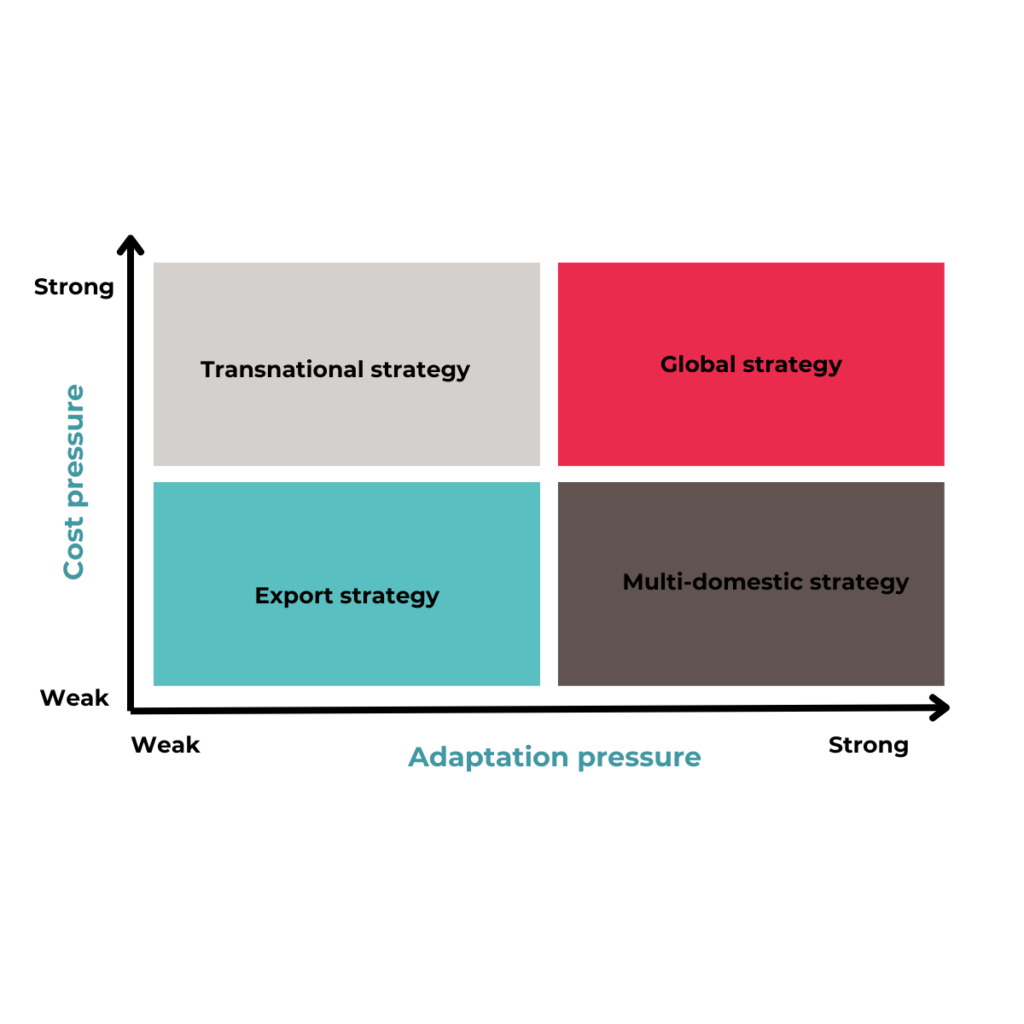For international business, the export marketing strategy is a critical determinant of success, with two important elements : standardization and adaptation. Standardization involves the uniform application of marketing strategies across international markets. On the other hand, adaptation is the need to tailor marketing efforts to the specific characteristics and preferences of each target market. This difference between standardization and adaptation presents a perpetual dilemma for businesses expanding globally, as you seek to find a delicate balance between achieving economies of scale and addressing the unique demands of diverse countries. This impacts and nuances the different international strategies available to you, which we’ll outline in detail below.
Cost saving strategy with standardization
Standardization in export marketing refers to the practice of using the same marketing strategies, product offerings, and promotional materials in multiple foreign markets without significant modification. The best example is Apple, who uses global markets for standardized consumer products on a previously unimagined scale of magnitude. Apple benefits from enormous economies of scale in production, distribution, marketing, and management. The only obstacles to standardization that Apple encounters are mainly regulations, which can differ from one country or zone to another and of course language.
Standardization can provide several competitive advantages. The cost reduction provided by economies of scale allows the firm to introduce competitive pricing. Management, distribution, marketing and production costs can be reduced because their processes are standardized. The brands standardized gain more recognition globally compared to brands utilizing local marketing strategies.
By using a standardization strategy when expanding internationally, companies run the risk of not being adapted to local market regulations and therefore facing difficulties in accessing the market. Furthermore, if there are changes in the market or regulations, this strategy offers less flexibility.
On 22 October 2022, the European Council gave its final approval to the Universal Charging Directive. This means that as of 2024, a USB-C port will become compulsory for a whole range of electronic devices such as mobile phones. On 12 September 2023, Apple announced the arrival of its new Iphone models, the Iphone 15, all of which feature a USB-C port rather than the Lightning connector found on previous models. In this case, Apple has chosen to adapt its products to the European market, because otherwise it would no longer be able to sell its products there.
Adaptation as an customer-orientation marketing strategy
Adaptation strategy involves customizing marketing strategies, product features, and promotional efforts to fit the specific needs, preferences, and characteristics of each market.
This strategy allows companies and exporters to be as close as possible to the needs of the consumers and to build their loyalty. But this strategy has one major drawback: its cost. Adapting your products or your marketing mix can lead to considerable additional costs and jeopardize your company’s profitability. It also adds additional complexities in terms of supply chain, marketing and R&D.
However, adaptation can be a deliberate choice in many situations. Depending on your sector of activity, local standards or regulations may differ from one country to another, forcing you to make adjustments. The same applies if your competitors are local companies because you risk losing your competitive advantage if you don’t adapt to the market.
When it comes to food, the cultural dimension and national traditions play a fundamental role. It is not possible to impose a single taste. It is also impossible, for reasons of purchasing power, to replicate locally produced products in Europe. For example, according to Djamila Hammouche lecturer at Sidi Bel Abbes University, Danone strongly encourages its subsidiaries to create products adapted to the local market. Danone’s marketing consists essentially in analyzing nutritional needs, tastes and eating habits in different countries. In each country, the company cooperates with research institutions and consumer associations to understand the local tastes and adapt accordingly.
What are the resulting strategies?
When internationalizing, it’s important to build a strategy that coincides with your resources and the typology of your products and/or services. You’ll need to understand whether the need to adapt is predominant or whether it’s cost pressure that will drive your strategy. Here are the four major internationalization strategies and all they imply for your company.

Export strategy
This strategy focuses on exporting products and services to foreign markets, while maintaining the company’s headquarters and production capacities in the country of origin. This avoids the need for companies adopting this form of internationalization to limit their investment in foreign facilities and personnel. With this type of strategy, most of the time your essential commercial objectives are primarily oriented towards the domestic market, but the international market can represent a significant part of the activity of your company that chooses this export-based solution.
Adopting an export strategy can be difficult, such as opening sales offices abroad, setting up local partnerships and, above all, managing global logistics and the number of requirements and compliance with the trade regulations in force in the countries you wish to penetrate.
Multi domestic strategy
The “multi-domestic” internationalization strategy invests in establishing a presence in the target foreign market, of the subsidiary type, and adapting its products to the local market. In this case, companies adapt their products and offers, and completely reposition their marketing strategies to appeal to a foreign audience. This includes taking into account the traditions and cultural aspects of the country or countries of interest.
In this multi-domestic approach, the company’s head office is often maintained in the country of origin. However, the company can set up a subsidiary from which it can more easily manage relations with its foreign customers.
Transnational Strategy
In an international transnational strategy, your company still operates from its headquarters in your country of origin, but you can develop through large-scale operations in foreign markets. The phenomenon whereby companies manufacture some of their products more cheaply abroad, is part of this transnational strategy.
In principle, transnational companies sell their products and services in several countries around the world. The difference lies in the way the product is marketed in each country. A product marketed from a “transnational” perspective is the same, regardless of the country in which it is sold. It is not modified to suit a new market, local customs or preferences.
Coca-Cola is a good example of a brand that uses a transnational strategy. Coca-Cola has more or less the same formula and taste. Wherever it’s sold around the world, the same logo and a similar marketing approach. The only thing that changes is the language on the bottle label.
Global strategy
It’s very rare for a multinational to be entirely standardized or adapted to foreign markets. Major exporting companies usually choose to “mix” the two strategies. In order to obtain the maximum benefits with the minimum drawbacks: this is the global strategy.
When companies adopt a global or worldwide strategy, they see the whole world as a single market. They take advantage of economies of scale to increase their reach and sales. In the end, companies that choose this type of approach offer relatively few local variations. As their products and services need to be homogenized as much as possible to reduce production and marketing costs. Even so, the most necessary adaptations are made so that the sale of products and services is maximized and possible in all countries. For example, fast-food companies such as McDonald’s or Burger King modify their menus and add or remove certain items to meet the needs of local markets.
How to make your choice ?
Making the choice between export marketing standardization and adaptation involves a careful consideration of several key factors. Here are some steps and considerations to guide the decision-making process:
Market Research: Conduct market research to understand the cultural, economic, and social dynamics of each target market. Identify similarities and differences among target markets in terms of business practices, consumer behaviors, preferences, and purchasing habits.
Product Characteristics: Evaluate the nature of your product or service. Some products may be standardized due to universal appeal, while others may require adaptation to meet specific market needs. For example, everyone knows that food tastes differ from one country to another. So it’s more likely that a food company will adopt a marketing export strategy of adaptation.
Regulatory Compliance: Understand and comply with local regulations and standards in each market. Your industry may face regulations that necessitate adaptation, while others may have more flexibility. The European Council gave its final approval to the Universal Charging Directive, proof that a legal framework can force manufacturers to modify their products, as is the case for Apple.
Cost Considerations: Analyze the costs associated with standardization and adaptation. Standardization may lead to cost savings through economies of scale, while adaptation may lead to expenses related to customization.
Competitive Landscape: Evaluate the strategies of your competitors in each country. Understand whether they are pursuing standardization or adaptation and the level of success they are achieving.Long-Term Strategic Goals: Align the chosen strategy with your long-term global expansion goals. Consider whether a standardized or adaptive approach better supports your company’s objectives.
Key take away
The choice between export marketing standardization and adaptation is an important decision that significantly influences your company’s success in global markets. Finding the right balance between these two strategies requires a nuanced understanding of various factors. Including market characteristics, product attributes, regulatory environments, and cultural differences.
Standardization offers the potential for cost efficiencies but your success relies on the assumption that consumer behaviors and preferences are relatively uniform across diverse countries. On the other hand, adaptation recognizes the heterogeneity of international markets and seeks to tailor marketing strategies for local consumers but may have costs and complexities in managing your activities.
The optimal choice often involves a dynamic approach that considers the two strategies by leveraging the benefits of standardization or adaptation. In essence, there is no one-size-fits-all solution, and the decision should align with your company’s long-term strategic goals.
Prime Target can accompany you in your international business project, and assist you in market potential evaluation. Prime Target’s Market Ranking Report can help you evaluate the market potential of 5, 10 or 20 countries simultaneously, and identify new export markets with the highest potential. This comprehensive and personalized Market Ranking Report can minimize risk, saving time and money, as well as identify new business opportunities abroad.




